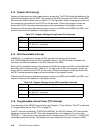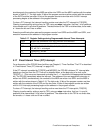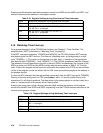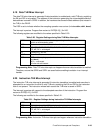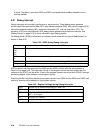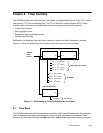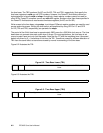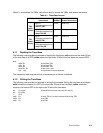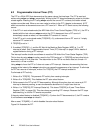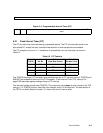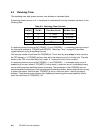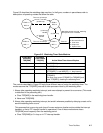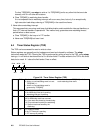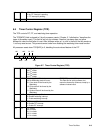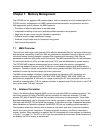
6-4 PPC405 Core User’s Manual
6.2 Programmable Interval Timer (PIT)
The PIT is a 32-bit SPR that decrements at the same rate as the time base. The PIT is read and
written using mfspr and mtspr, respectively. Writing to the PIT also simultaneously writes to a hidden
reload register. Reading the PIT using mfspr returns the current PIT contents; the hidden reload
register cannot be read. When a non-zero value is written to the PIT, it begins to decrement. A PIT
event occurs when a decrement occurs on a PIT count of 1. When a PIT event occurs, the following
occurs:
1. If the PIT is in auto-reload mode (the ARE field of the Timer Control Register (TCR) is 1), the PIT is
loaded with the last value an mtspr wrote to the PIT. A decrement from a PIT count of 1
immediately causes a reload; no intermediate PIT content of 0 occurs.
If the PIT is not in auto-reload mode (TCR[ARE] = 0), a decrement from a PIT count of 1 simply
causes a PIT content of 0.
2. TSR[PIS] is set to 1.
3. If enabled (TCR[PIE] = 1 and the EE field of the Machine State Register (MSR) is 1), a PIT
interrupt is taken. See “Programmable Interval Timer (PIT) Interrupt” on page 5-22 for details of
register behavior during a PIT interrupt.
The interrupt handler should use software to reset the PIS field of the Timer Status Register (TSR).
This is done by using mtspr to write a word to the TSR having a 1 in TSR[PIS] and any other bits to
be cleared, and a 0 in all other bits. The data written to the TSR is not direct data, but a mask. A 1
clears a bit; a 0 has no effect.
Using mtspr to force the PIT to 0
does not
cause a PIT interrupt. However, decrementing that was
ongoing at the instant of the mtspr instruction can cause the appearance of an interrupt. To eliminate
the PIT as a source of interrupts, write a 0 to TCR[PIE], the PIT interrupt enable bit.
To eliminate all PIT activity:
1. Write a 0 to TCR[PIE]. This prevents PIT activity from causing interrupts.
2. Write a 0 to TCR[ARE]. This disables the PIT auto-reload feature.
3. Write zeroes to the PIT to halt PIT decrementing. Although this action does not cause a pit PIT
interrupt to become pending, a near-simultaneous decrement to 0 might have done so.
4. Write a 1 to TSR[PIS] (PIT Interrupt Status bit). This clears TSR[PIS] to 0 (see “Timer Status
Register (TSR)” on page 6-8). This also clears any pending PIT interrupt. Because the PIT stops
decrementing, no further PIT events are possible.
If the auto-reload feature is disabled (TCR[ARE] = 0) when the PIT decrements to 0, the PIT remains
0 until software uses mtspr to reload it.
After a reset, TCR[ARE] = 0, which disables the auto-reload feature.
Figure 6-4 illustrates the PIT.



